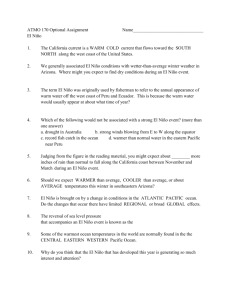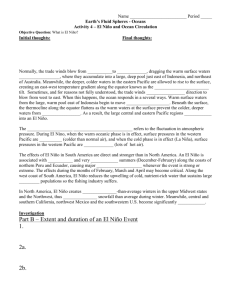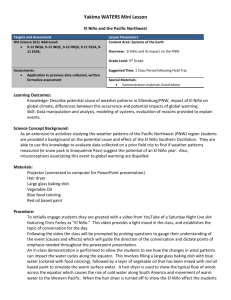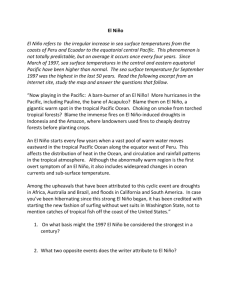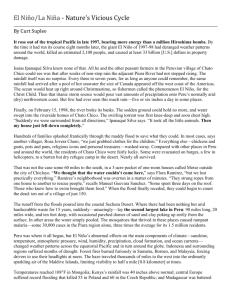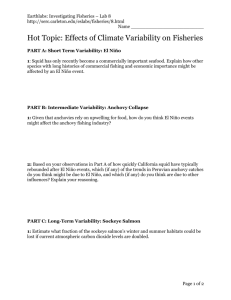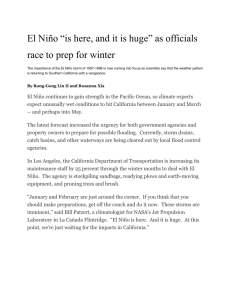Markets Gird for Return of El Niño
advertisement
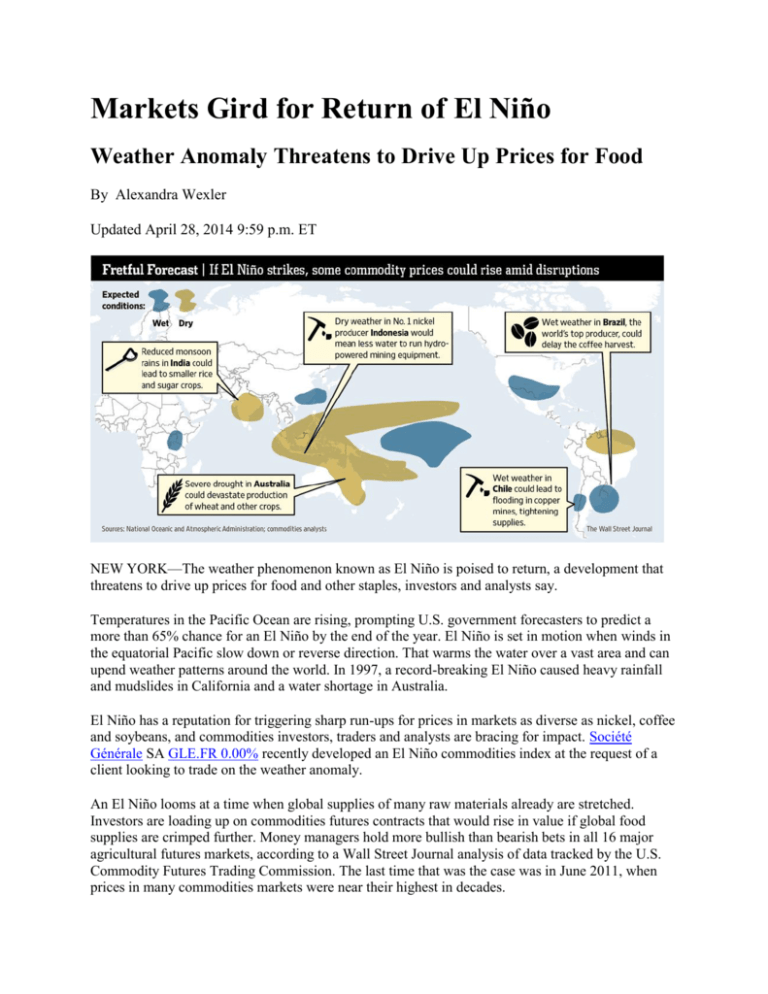
Markets Gird for Return of El Niño Weather Anomaly Threatens to Drive Up Prices for Food By Alexandra Wexler Updated April 28, 2014 9:59 p.m. ET NEW YORK—The weather phenomenon known as El Niño is poised to return, a development that threatens to drive up prices for food and other staples, investors and analysts say. Temperatures in the Pacific Ocean are rising, prompting U.S. government forecasters to predict a more than 65% chance for an El Niño by the end of the year. El Niño is set in motion when winds in the equatorial Pacific slow down or reverse direction. That warms the water over a vast area and can upend weather patterns around the world. In 1997, a record-breaking El Niño caused heavy rainfall and mudslides in California and a water shortage in Australia. El Niño has a reputation for triggering sharp run-ups for prices in markets as diverse as nickel, coffee and soybeans, and commodities investors, traders and analysts are bracing for impact. Société Générale SA GLE.FR 0.00% recently developed an El Niño commodities index at the request of a client looking to trade on the weather anomaly. An El Niño looms at a time when global supplies of many raw materials already are stretched. Investors are loading up on commodities futures contracts that would rise in value if global food supplies are crimped further. Money managers hold more bullish than bearish bets in all 16 major agricultural futures markets, according to a Wall Street Journal analysis of data tracked by the U.S. Commodity Futures Trading Commission. The last time that was the case was in June 2011, when prices in many commodities markets were near their highest in decades. If an El Niño forms, it is "going to be a very stressful summer," said Hector Galvan, a senior market strategist at RJO Futures in Chicago. "It's just more fuel to the fire for these markets.'" El Niño can work its way through commodities markets in surprising ways. While unpredictable rainfall is El Niño's signature feature, analysts at Société Générale found that it was miners, not farmers, who had the most to worry about. Since 1991, nickel prices rose the most— 13.9%—during El Niño years among the 11 commodities the bank's index tracks. The reason: El Niño causes dry weather in Indonesia, the world's top producer of the metal, which is used to strengthen steel. Mining equipment in the country relies heavily on hydropower; the less it rains, the less nickel can be produced. "You could make a large amount of money by going long nickel if we have an El Niño," said Michael Haigh, global head of commodities research at SocGen. A long position is a bet that prices will rise. Nickel prices already have jumped this year due to new export restrictions in Indonesia. A wall of mud on an Orange County Calif. road in 1998, after a record-breaking El Niño caused heavy rainfall and mudslides. Associated Press The name El Niño is a Spanish reference to the Christ child because it often comes around Christmas, though forecasters in Australia say the next one could form as soon as July. More extreme weather could further boost already rising prices of commodities such as coffee, sugar and soybeans, stretching consumer budgets and undermining economic recovery in developed nations. Higher commodities prices also could trigger unrest in poor countries that import much of their food supply, analysts say. "These kinds of weather pressures, combined with El Niño, could create a nasty combination," said John Baffes, a senior economist at the World Bank. "Basically if we have an El Niño year and prices skyrocket, then we certainly are going to see some unrest." Global food prices—which at the start of 2014 were expected to be largely flat this year—could easily climb 15% to record highs in as a little as three months after an El Niño occurs, said Mr. Baffes, who co-wrote the World Bank's quarterly commodities outlook released Thursday. Mr. Baffes pointed to North Africa and the Middle East, which are highly dependent on grain imports, as potential hot spots. He added that India—which typically sees less rain during its monsoon season in an El Niño year—also could be hard-hit, as it consumes almost all of the staple crops like rice and wheat that its farmers grow. Drought-stricken Brazilian coffee farmers would welcome the rains El Niño typically brings to the region if they came today. But in July or August, downpours would only slow the harvest, further reducing supplies of arabica beans, which are prized for their mild taste. Arabica prices have nearly doubled this year on supply concerns. Chocolate lovers also may have a reason to worry. El Niño reduces cocoa production by an average of 2.4%, according to the International Cocoa Organization. That would come on top of an already expected shortfall that has driven up prices 8.7% this year. Not all of El Niño's effects are bad. The phenomenon typically brings wet weather to California, which has been ravaged by drought this year. That could benefit crops such as limes, almonds and avocados. Prices for all three commodities, which don't trade on exchanges, are up sharply this year. "If the markets are concerned more about weather patterns across the country and across the globe, that's going to find their way to prices," said Matt Forester, chief investment officer at CFG Asset Management, an investment adviser in Newtown Square, Pa. with about $335 million under management. His firm bought shares in the iPath Pure Beta Coffee exchange-traded note last month and has increased its exposure this year to the Greenhaven Continuous Commodity Index Fund's exchangetraded fund, which is 58% agricultural commodities. El Niño has been blamed for droughts in Australia. Above, parched farmland in New South Wales in 2006. Bloomberg News If El Niño disrupts production in key growing regions, it will help the bottom line of companies that specialize in the logistics of the agricultural trade, said Desmond Cheung, manager of the agricultural-equities arm of BlackRock Inc.'s $441 million Commodity Strategies Fund. That includes firms like Archer Daniels Midland Co., Bunge Ltd., Cargill Inc. and Louis Dreyfus Commodities BV. "We do like the sector as a whole," Mr. Cheung said. El Niño "is certainly bullish for a number of different crops," said Stefan Kip Astheimer, vice president of strategy at Howe and Rusling, Inc., an investment adviser with about $800 million under management. He added: "Our perspective is that whenever there's a weather factor, it is something to be aware of, but not overly zealous in pricing it in ahead of time." But with many markets already battered by weather this year, an El Niño could be the final straw. Darwei Kung, portfolio manager of Deutsche Asset & Wealth Management's $733 million DWS Enhanced Commodity Strategy Fund, said he expects an El Niño this year would have the largest impact on sugar and coffee, two markets that already have risen 82% and 7% this year. "Clearly we do watch for those weather issues," Mr. Kung said, "and look at how much worse things can get." Write to Alexandra Wexler at alexandra.wexler@wsj.com

